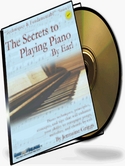----------------------------------------------------- Exciting Announcements! ----------------------------------------------------- HearandPlay.com Chatroom: Visit: https://www.hearandplay.com/chat every Monday and Thursday night as I answer your questions, share new chords and progressions, and help you to overcome any issues you're facing. HearandPlay.com Toolbar: Visit http://www.hearandplaytoolbar.com to download our free internet toolbar. This tool will allow you to access every resource section on our site ... INSTANTLY!
 "The
Secrets to Playing Piano By Ear"
300pg Course - Learn the secrets to playing literally any song
on the piano with a few simple, "easy-to-understand" techniques and
principles! Join Jermaine Griggs in learning tons of music theory,
concepts, and tricks that will help you to learn piano by ear! Thousands
of musicians have already taken advantage of this excellent program ...
why not you? "The
Secrets to Playing Piano By Ear"
300pg Course - Learn the secrets to playing literally any song
on the piano with a few simple, "easy-to-understand" techniques and
principles! Join Jermaine Griggs in learning tons of music theory,
concepts, and tricks that will help you to learn piano by ear! Thousands
of musicians have already taken advantage of this excellent program ...
why not you?
"The Secrets to Playing Piano By Ear" is full of easy-to-understand tricks, tips, techniques and secrets to playing piano by ear! For this month only, I've also been able to throw in a few bonus items (3 additional piano software programs). Click here to learn the secrets to playing absolutely any song on the piano in virtually minutes! You won't regret it! |
------------------------------------------------------------------------------- Online Classroom: "The 7-3-6-2-5-1 Progression and How to Use It!" -------------------------------------------------------------------------------- Note: You might want to print this lesson out for easier reading... Let's get right to work with this month's online classroom. In the past, I've given you one-fingered bass notes to play on your left hand. In this lesson, I will give you three-fingered left hand voicings so that you'll get used to playing "bigger" chords. These progressions will also be in the key of Db major: NOTES IN PARENTHESIS ( ) DON'T NECESSARILY HAVE TO BE PLAYED IF YOU CAN'T REACH THEM. #1
|
Left hand
C + G + Bb ("7") |
Right hand Eb + G + Bb + D + (F) |
| F + C + Eb ("3") |
A + Db + Eb + Ab |
| Bb + F + Ab ("6") |
Ab + C + Db + F + (Ab) |
| Eb + Bb + Db ("2") |
G + C + Db + F + (A) |
| Ab + Eb + Gb ("5") |
Gb + Bb + B + Eb |
| Db + Ab + B ("1") |
F + Bb + B + Eb |
After the "1" chord, it is common to go to a "4" chord:
Left hand: Gb + Db + F / Right hand: F + Bb + Db
or...
Left hand: Gb + Db + F / Right hand: Bb + Eb + F Bb
#2
|
Left hand |
Right hand |
| C + G + Bb ("7") |
Bb + Eb + Gb |
| F + C + Eb ("3") |
A + D + Gb |
| Bb + F + Ab ("6") |
Ab + C + Eb + G |
| Eb + Bb + Db ("2") |
Gb + Bb + Db + F |
| Ab + Eb + Gb ("5") |
C + F + A |
| Db + Ab + B ("1") |
Bb + Eb + Ab |
This concludes May's Online Classroom Lesson If you were intrigued by the online classroom lesson above, then you would definitely benefit from my course! *** “The Secrets to Playing Piano By Ear” 300-pg Course *** With 20 chapters and over 300 pages, the home piano course provides several resources, techniques, tips, principles, and theories to playing the piano by ear. Along with hundreds of chords and scales, you'll also learn how to turn them into gospel, jazz and blues chord progressions and better yet, how to use them to play ABSOLUTELY any song you want ... IN VIRTUALLY MINUTES! Again, don't miss this opportunity. I've even added an additional bonus if you purchase the course this week --- You can read more about the course at: https://www.hearandplay.com/course
------------------------------------------ Enjoy this edition? Visit our message board and let us know! http://board.hearandplay.net Please Let a friend know about HearandPlay.com! PLEASE FORWARD THIS NEWSLETTER TO YOUR ENTIRE E-MAIL ADDRESS BOOK. ------------------------------------------ Yours Truly, Jermaine Griggs www.HearandPlay.com
Further References"The Secrets to Playing Piano By Ear" 300-pg Course [5] Chord Progressions: pgs 65-78, 105-130, 147-165, 182-227.Do you know what a “2-5-1” or "3-6-2-5-1" progression is? Or perhaps the famous 12-bar blues chord progression? In this piano course, you will not only learn how to play gospel, blues, and jazz progressions, but how to recognize them in songs. In addition, you will learn the simple techniques to playing these progressions, hymns, and songs in all 12 major keys! ... Enjoy learning:
|